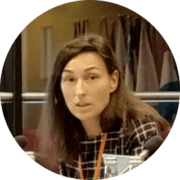A meeting about humanizing the process for returning migrant children in the CIS region to their home countries took place on September 20 as part of the OSCE conference. This meeting was organized by ADC Memorial and coincided with the #CrossborderChildhood campaign. We asked some of the featured experts from Moldova, Ukraine, Kazakhstan, and Uzbekistan to explain why the problem of returning migrant children to their home countries is important, how existing procedures should be changed, and what stood out most for them about the conference.
 Mariana Ianachevici (Ave Copiii, Moldova)
Mariana Ianachevici (Ave Copiii, Moldova)
Why is the return of migrant children an important topic?
The question of returning children is a question of protecting the rights of the child, in particular the right to a family. In the context of contemporary migration, return should be based on the child’s best interests and not on the priorities of social services. Sometimes it is in the child’s interest not to be returned to their country of citizenship, but to remain where they are, because, for example, the most important family members for the child may be in that country.
Today, the question of return must be handled differently than before: This process now involves many more procedures and government agencies. In our region of the former Soviet Union, the return of children was a simple procedure between reception centers within the shared system of the Ministry of Internal Affairs. Now children have to obtain their documents through embassies, and then social services, the police, and border guards get involved.
How can the existing procedure be changed?
I see the process of returning children through the prism of protecting children’s rights. I do not believe that child migrants who get into trouble should be returned to their native country just because they are foreigners. Countries in our region will continue to have problems with returning children and violation of children’s rights until these countries remove migrant children from the Ministry of Internal Affairs system and assign these matters to children’s services. All countries have their own nuances, but Ministry of Internal Affairs structures should not perform transport or social services functions; they have their own mandate. In addition, return is not just a transport process with rules similar to the ones for transporting passengers. The best interests of the child must be determined during this procedure. If a child is moved from one children’s home to another, this is unlikely to improve the situation. The end result must be finding a family for the child, be it a foster family or the birth family. It is important to determine if the child wants to return: Sometimes violence in the family or other problems can be the reason why a child does not want to return home. It is important to prepare the child and lay out all the details; the process must be transparent. Also, a plan for reintegrating the child must be made immediately. This includes provision of protection, placement in a family, and further rehabilitation prior to return so that no time is wasted. And professional monitoring after return is vital: what happened with the child after return, is everything in order, did return help. This monitoring system and exchange of information between countries must exist. This is still not the norm for countries in Eastern Europe and Central Asia. But we have become accustomed to this approach in our work with our Western European partners and we see how effective it is in practice.
What did you get from the HDIM 2019 conference?
Meetings involving so many representatives from different countries in such a wide-ranging format give me the opportunity to speak with various specialists and learn more about the situation in different countries firsthand. HDIM helps us understand contemporary trends in the region and “keep our fingers on the pulse.” This is also useful for the work of my organization, Ave Copiii: I can understand what risks exist for children and families in the countries they leave for Moldova and in the countries where Moldovan children end up. By speaking with my colleagues, I can understand why it is harder to return children in some cases and easier in others. For me, the takeaway from these meetings is practical information that I can use in my work.
 Katerina Budiyanskaya
Katerina Budiyanskaya
(Right to Protection, Ukraine)
Why is the return of migrant children an important topic?
In most cases (although, of course, not all), ensuring the best interests of the child (the main principle established by the Convention on the Rights of the Child) means family reunification. To implement this procedure, we need a humane return procedure that corresponds to the Convention on the Rights of the Child.
How can the existing procedure be changed?
A state’s concern for children must be expressed in a humane procedure that corresponds to the principles of the Convention on the Rights of the Child. The return procedure should envisage the mandatory collection of information about why the child left their family or environment, an assessment of the child’s living conditions, an accounting of the child’s opinion, monitoring of the situation to which the child was returned, the work of a psychologist at all stages, the appointment of a legal representative immediately following the child’s identification and prior to the child’s final transfer to parents or people taking their place, and the maintenance of the child in the country of identification in conditions that should at the very least not be worse than the conditions in which children left without parental care who are citizens of this country are kept.
What did you get from the HDIM 2019 conference?
A clear understanding that the Chisinau Agreement must be replaced, since some states already have a different system and procedure for returning migrant children to their country of permanent residence.
 Khadzhiakbar Isakov
Khadzhiakbar Isakov
(attorney from the Istiqbolli Avlod Republican Social and Information Center, Uzbekistan)
Why is the return of migrant children an important topic?
Migrants comprise an extremely vulnerable layer of the population. They have many difficulties in the processes of migration and adaptation in their local communities, including lack of money, ignorance of the language, lack of accessibility to high-quality medical care, and, frequently, a low level of legal awareness and a lack of education. Migrant children suffer even more: Their parents often do not know how to enroll them in kindergarten or school, or how to get them the documents they need. This is why state monitoring in this area must be carried out in full compliance with the rights of the child, especially if a child has been left without guardians or legal representatives. This topic is extremely pertinent in our region.
How can the existing procedure be changed?
I think there should be one system for returning children that accounts for international standards. We must develop a single mechanism for identifying children who are in need of assistance or who are in a critical or vulnerable position, a single standard for providing comprehensive assistance to these children, and a mechanism for returning children that works in their best interests. Structures responsible for returning children in countries throughout the region must be able to share information.
What did you get from the HDIM 2019 conference?
It was interesting and useful for me to participate in this conference. Both the side event and the plenary session were opportunities for me to share experience, meet other people, and learn about the best practices and difficulties in other countries. And, of course, this was an excellent opportunity for our organization to report on its activities and the experience of Uzbekistan in general.









 Feedback
Feedback